Related Research Articles

In vascular plants, the roots are the organs of a plant that are modified to provide anchorage for the plant and take in water and nutrients into the plant body, which allows plants to grow taller and faster. They most often lie below the surface of the soil, but roots can also be aerial or aerating, that is, growing up above the ground or especially above water.

Kudzu is a group of climbing, coiling, and trailing perennial vines native to much of East Asia, Southeast Asia, and some Pacific islands, but invasive in many parts of the world, primarily North America.

Willows, also called sallows and osiers, form the genus Salix, are around 400 species of deciduous trees and shrubs, found primarily on moist soils in cold and temperate regions of the Northern Hemisphere. Most species are known as willow, but some narrow-leaved shrub species are called osier, and some broader-leaved species are referred to as sallow. Some willows are low-growing or creeping shrubs; for example, the dwarf willow rarely exceeds 6 cm (2.4 in) in height, though it spreads widely across the ground.

Armillaria is a genus of fungi that includes the A. mellea species known as honey fungi that live on trees and woody shrubs. It includes about 10 species formerly categorized summarily as A. mellea. Armillarias are long-lived and form some of the largest living organisms in the world. The largest known organism covers more than 3.4 square miles (8.8 km2) in Oregon's Malheur National Forest and is more than 2,400 years old. Some species of Armillaria display bioluminescence, resulting in foxfire.
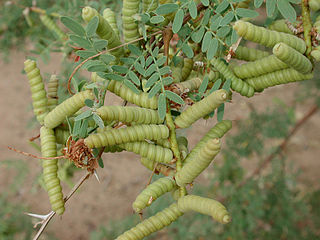
Mesquite is a common name for several plants in the genus Prosopis, which contains over 40 species of small leguminous trees. They are native to the southwestern United States and Mexico. The mesquite originates in the Tamaulipan mezquital ecoregion, in the deserts and xeric shrublands biome, located in the southern United States and northeastern Mexico. It has extremely long roots to seek water from very far under ground. The region covers an area of 141,500 km2, encompassing a portion of the Gulf Coastal Plain in southern Texas, northern Tamaulipas, northeastern Coahuila, and part of Nuevo León. As a legume, mesquite is one of the few sources of fixed nitrogen in the desert habitat.

A sanitary sewer or foul sewer is an underground pipe or tunnel system for transporting sewage from houses and commercial buildings to treatment facilities or disposal. Sanitary sewers are part of an overall system called a sewage system or sewerage.

Roto-Rooter Plumbing & Water Cleanup was formerly called Roto-Rooter Plumbing & Drain Service Roto-Rooter provides plumbing repair, sewer & drain services, and water damage cleanup services to residential and commercial customers. Roto-Rooter is a United States company founded in 1935 which originally specialized in clearing tree roots and other obstructions from sewer lines. As of 2020 it employs thousands of plumbers, and service technicians throughout the U.S. and Canada who provide plumbing and sewer and water damage cleanup services. Roto-Rooter also employs manufacturing technicians and assembly workers at its manufacturing plant in West Des Moines, Iowa. The plant manufactures the company's patented, proprietary Roto-Rooter sewer and drain cleaning machines as well as sewer and drain cleaning cables and blades. Roto-Rooter is a subsidiary of publicly traded Chemed Corporation, which also owns a hospice company, VITAS Healthcare.
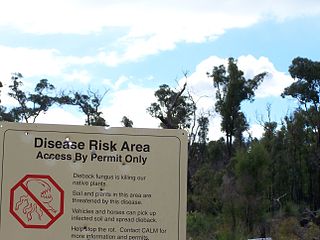
Phytophthora cinnamomi is a soil-borne water mould that produces an infection which causes a condition in plants variously called "root rot", "dieback", or, "ink disease". The plant pathogen is one of the world's most invasive species and is present in over 70 countries around the world.

Ailanthus altissima, commonly known as tree of heaven, ailanthus, varnish tree, or in Chinese as chouchun, is a deciduous tree in the family Simaroubaceae. It is native to northeast and central China, and Taiwan. Unlike other members of the genus Ailanthus, it is found in temperate climates rather than the tropics.
Pipeline video inspection is a form of telepresence used to visually inspect the interiors of pipelines, plumbing systems, and storm drains. A common application is for a plumber to determine the condition of small diameter sewer lines and household connection drain pipes.
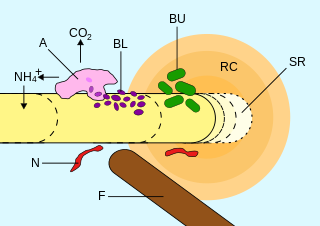
The rhizosphere is the narrow region of soil or substrate that is directly influenced by root secretions and associated soil microorganisms known as the root microbiome. The rhizosphere involving the soil pores contains many bacteria and other microorganisms that feed on sloughed-off plant cells, termed rhizodeposition, and the proteins and sugars released by roots, termed root exudates. This symbiosis leads to more complex interactions, influencing plant growth and competition for resources. Much of the nutrient cycling and disease suppression by antibiotics required by plants, occurs immediately adjacent to roots due to root exudates and metabolic products of symbiotic and pathogenic communities of microorganisms. The rhizosphere also provides space to produce allelochemicals to control neighbours and relatives.

Hedera helix, the common ivy, English ivy, European ivy, or just ivy, is a species of flowering plant in the family Araliaceae, native to most of Europe and western Asia. A rampant, clinging evergreen vine, it is a familiar sight in gardens, waste spaces, on walls, tree trunks and in wild areas across its native habitat. As a result of its hardy nature, and its tendency to grow readily without human assistance, English ivy has attained popularity as an ornamental plant, and escaped plants have led to naturalisations outside its native range.

A parasitic plant is a plant that derives some or all of its nutritional requirement from another living plant. They make up about 1% of angiosperms and are found in almost every biome. All parasitic plants have modified roots, called haustoria, which penetrate the host plant, connecting them to the conductive system – either the xylem, the phloem, or both. For example, plants like Striga or Rhinanthus connect only to the xylem, via xylem bridges (xylem-feeding). Alternately, plants like Cuscuta and Orobanche connect only to the phloem of the host (phloem-feeding). This provides them with the ability to extract water and nutrients from the host. Parasitic plants are classified depending as to the location where the parasitic plant latches onto the host and the amount of nutrients it requires. Some parasitic plants are able to locate their host plants by detecting chemicals in the air or soil given off by host shoots or roots, respectively. About 4,500 species of parasitic plant in approximately 20 families of flowering plants are known.
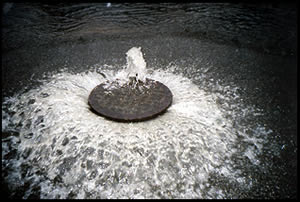
Sanitary sewer overflow (SSO) is a condition in which untreated sewage is discharged from a sanitary sewer into the environment prior to reaching sewage treatment facilities. When caused by rainfall it is also known as wet weather overflow. It is primarily meaningful in developed countries, which have extensive treatment facilities. Frequent causes of SSO spills include:

Armillaria luteobubalina, commonly known as the Australian honey fungus, is a species of mushroom in the family Physalacriaceae. Widely distributed in southern Australia, the fungus is responsible for a disease known as Armillaria root rot, a primary cause of Eucalyptus tree death and forest dieback. It is the most pathogenic and widespread of the six Armillaria species found in Australia. The fungus has also been collected in Argentina and Chile. Fruit bodies have cream- to tan-coloured caps that grow up to 10 cm (4 in) in diameter and stems that measure up to 20 cm (8 in) long by 1.5 cm (1 in) thick. The fruit bodies, which appear at the base of infected trees and other woody plants in autumn (March–April), are edible, but require cooking to remove the bitter taste. The fungus is dispersed through spores produced on gills on the underside of the caps, and also by growing vegetatively through the root systems of host trees. The ability of the fungus to spread vegetatively is facilitated by an aerating system that allows it to efficiently diffuse oxygen through rhizomorphs—rootlike structures made of dense masses of hyphae.

Heterobasidion annosum is a basidiomycete fungus in the family Bondarzewiaceae. It is considered to be the most economically important forest pathogen in the Northern Hemisphere. Heterobasidion annosum is widespread in forests in the United States and is responsible for the loss of one billion U.S. dollars annually. This fungus has been known by many different names. First described by Fries in 1821, it was known by the name Polyporus annosum. Later, it was found to be linked to conifer disease by Robert Hartig in 1874, and was renamed Fomes annosus by H. Karsten. Its current name of Heterobasidion annosum was given by Brefeld in 1888. Heterobasidion annosum causes one of the most destructive diseases of conifers. The disease caused by the fungus is named annosus root rot.
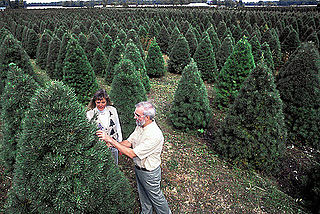
Pine and fir trees, grown purposely for use as Christmas trees, are vulnerable to a wide variety of pests, weeds and diseases. Many of the conifer species cultivated face infestations and death from such pests as the balsam woolly adelgid and other adelgids. Aphids are another common insect pest. Christmas trees are also vulnerable to fungal pathogens and their resultant illnesses such as root rot, and, in the U.S. state of California, sudden oak death. Douglas-fir trees in particular are vulnerable to infections from plant pathogens such as R. pseudotsugae.

2,6-Dichlorobenzonitrile (DCBN or dichlobenil) is an organic compound with the chemical formula C6H3Cl2CN. It is a white solid that is soluble in organic solvents. It is widely used as an herbicide.

A weed is a plant considered undesirable in a particular situation, "a plant in the wrong place". Examples commonly are plants unwanted in human-controlled settings, such as farm fields, gardens, lawns, and parks. Taxonomically, the term "weed" has no botanical significance, because a plant that is a weed in one context is not a weed when growing in a situation where it is in fact wanted, and where one species of plant is a valuable crop plant, another species in the same genus might be a serious weed, such as a wild bramble growing among cultivated loganberries. In the same way, volunteer crops (plants) are regarded as weeds in a subsequent crop. Many plants that people widely regard as weeds also are intentionally grown in gardens and other cultivated settings, in which case they are sometimes called beneficial weeds. The term weed also is applied to any plant that grows or reproduces aggressively, or is invasive outside its native habitat. More broadly "weed" occasionally is applied pejoratively to species outside the plant kingdom, species that can survive in diverse environments and reproduce quickly; in this sense it has even been applied to humans.

Kudzu is an invasive plant species in the United States. Its introduction has produced devastating environmental consequences. This has earned it the nickname "the vine that ate the South". It has been spreading rapidly in the Southern United States, "easily outpacing the use of herbicide spraying and mowing, as well increasing the costs of these controls by $6 million annually". Estimates of the vine's spread vary, from the United States Forest Service's 2015 estimate of 2,500 acres per year to the Department of Agriculture's estimate of as much as 150,000 acres annually.
References
- Roberts, Jackson & Smith; John Roberts; Nick Jackson; Mark Smith (2006). Tree roots in the built environment. The Stationery Office. p. 506. ISBN 0-11-753620-2.
- Schmid, Wolfram George (2002). An encyclopedia of shade perennials. Timber Press. p. 374. ISBN 0-88192-549-7.
- White, Robert Edwin (2003). Soils for fine wines. Oxford University Press US. p. 279. ISBN 0-19-514102-4.